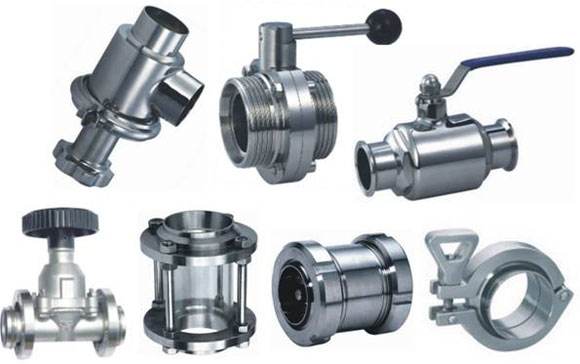| กก
|

Sanitary Valves are designed for use in applications requiring clean or sterile processing. Sanitary valves are commonly used in dairy, food, pharmaceutical, medical, and chemical applications. Common features include easy cleaning, crevice free, and polished contact surfaces. Valve types include globe, diaphragm, pinch, knife or gate, needle, butterfly, ball, and plug.
Globe valves are linear motion valves with rounded bodies, from which their name is derived. They are widely used in industry to regulate fluid flow in both on/off and throttling service. Diaphragm valves are related to pinch valves, but use an elastomeric diaphragm, instead of an elastomeric liner in the valve body, to separate the flow stream from the closure element. Pinch valves include any valve with a flexible elastomeric body that can be pinched closed, cutting off flow, using a mechanism or fluid pressure. Pinch valves are full bore, linear action valves so they can be used in both an off/on manner or in a variable position or throttling service. Gate or knife valves are linear motion valves in which a flat closure element slides into the flow stream to provide shut-off.
Gate valves are usually divided into two types: parallel and wedge-shaped. Needle valves have a slender, tapered point at the end of the valve stem that is lowered through the seat to restrict or block flow. Fluid flowing through the valve turns 90 degrees and passes through an orifice that is the seat for a rod with a cone shaped tip. Butterfly sanitary valves are quick opening valves that consist of a metal circular disc or vane with its pivot axes at right angles to the direction of flow in the pipe, which when rotated on a shaft, seals against seats in the valve body. They are normally used as throttling valves to control flow. Ball valves provide tight shut-off and characterizable control. They have high rangeability due to the design of the regulating element, without the complications of side loads typical of butterfly or globe valves. Plug sanitary valves, also called cock or stop-cock valves, date back to ancient times, where they were developed for use in citywide Roman plumbing systems. Today, they remain one of the most widely used valves for both on/off and throttling services.
Important specifications when considering sanitary valves include diameter, working pressure, and operating temperature. The diameter is measured across the inlet or outlet port. The working pressure is the pressure at which the valve is designed to operate. The operating temperature is the full-required range of ambient operating temperature. Media types that sanitary valves can be configured to work with include gases, liquids, and liquids with suspended solids. The material temperature is the range of temperature that the valve can withstand and still function properly. This relates to the media being transported, not the ambient or operating temperature outside of the system.
The body material of sanitary valves can be metal or plastic. Metal choices include brass, bronze, copper, cast iron, ductile iron, stainless steel, and steel.
Plastic choices include PVC and CPVC. Common end connections include threaded, socket-weld or buttweld, push on, solder end, clamp, grooved end, flangeless wafer-style, lugged, mechanical joint and flanged. Sanitary valve actuation types include electric, pneumatic, hydraulic, and manual.
ANSI Class ratings common to sanitary valves include Class125, Class 150, Class 200, Class 300, Class 600, Class 800, Class 900, and Class 1500. Other standards and specifications that sanitary valves can meet are API standards, MSS specifications, UL listings, ASME standards and federal specifications WW-V-35C.
NEWTON VALVEoffers a broad line of Sanitary Valves and Fittings Covering Sanitary Ball Valve, Sanitary Butterfly Valve, Sanitary Check Valve, Sanitary Stop Valve, Sanitary Diaphragm Valve, Sanitary Driving Valve, Sight Glass, Clamp and Unions etc.
|
กก |





